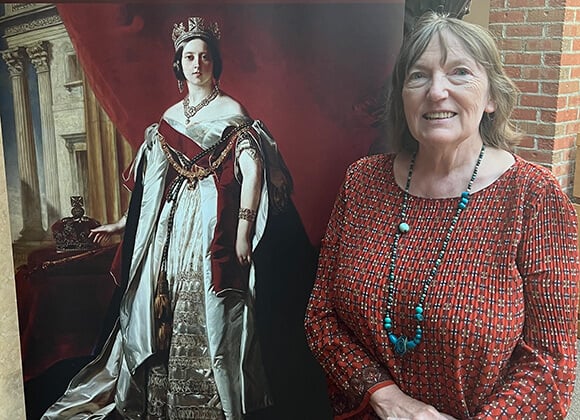
Ireland’s Great Hunger Institute at Quinnipiac launches ‘The Famine Queen: Victoria and The Great Hunger’
October 03, 2023

October 03, 2023

In Irish famine historiography, Queen Victoria remains a contested figure. Was she indifferent to the suffering of the Irish poor during the Great Hunger or, as a recent popular British TV show suggested, was she engaged and compassionate?
To that end, Ireland’s Great Hunger Institute at Quinnipiac has launched the exhibition, “The Famine Queen: Victoria and The Great Hunger.”
The exhibition opened Sept. 29 and runs until August in the Arnold Bernhard Library.
It is curated by Christine Kinealy, professor of history and director of Ireland’s Great Hunger Institute, and Robert Young, public services librarian.
“It’s an exhibit that looks at the early life of Queen Victoria, who was on the throne during the period known as the Great Hunger,” Kinealy said. “She interacted with Ireland in various ways, but later on in her reign, Irish people labeled her the famine queen because they believed she had done too little.”
Using contemporary archival sources — a number of which are part of Quinnipiac’s unique Irish collection—the complex relationships between the British monarchy and the starving people of Ireland will be explored.
At a time when food insecurity, famine and displacement are on the increase, this exhibition explores issues that remain deeply relevant today.
The exhibition includes information on Queen Victoria’s background, her marriage to Prince Albert and their nine children, a selection of her etchings, a handwritten letter she penned in 1847 about the famine and a diary featuring an artist’s drawing of Queen Victoria created in 1846.
Another highlight is a copy of Irish revolutionary Maud Gonne’s article dubbing Victoria, “The Famine Queen,” written in 1900 when Victoria visited Ireland for the fourth and final time.
“It was banned by the British authorities, and in it Maud Gonne lambasted Queen Victoria for allowing so many women to be deprived of their children as a result of starvation,” Kinealy said. “It’s a very powerful article and that name in Ireland stuck. We remember her as ‘The Famine Queen.’”
“There is a tremendous amount of excitement around this exhibition,” Young added.
The exhibition, which is free and open to the public, is open Monday through Saturday from 9 a.m.-5 p.m., and Sundays from noon-5 p.m.
Quinnipiac Today is your source for what's happening throughout #BobcatNation. Sign up for our weekly email newsletter to be among the first to know about news, events and members of our Bobcat family who are making a positive difference in our world.
Sign Up Now